The first significant date in a child’s life is six months. Starting from this age, the baby gradually turns into a person. Every day, your baby will surprise you with the appearance of new communication skills, the manifestation of your personality and character. The development of a child at 6 months brings huge changes in the mental and physiological spheres of the baby, especially with regard to changes in nutrition and mode.
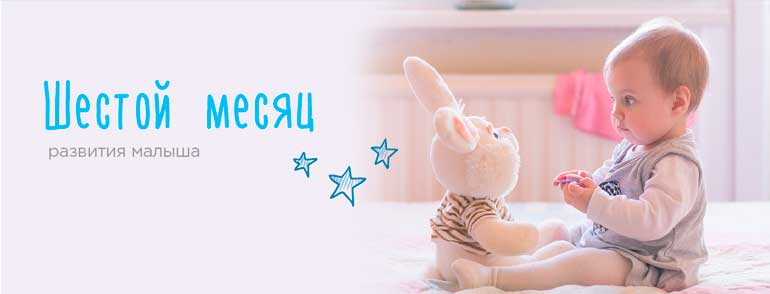
Physical development
In order to assess the physical development of the child, pediatricians use centile tables, which indicate the norms for months. For boys and girls, they are different. In addition to weight and body length, the tables contain indicators of the circumference of the head and chest, which are also important to consider when assessing the physical development of the baby. A child at 6 months should have the following indicators: weight 6.8 - 8.4 kg (± 1 kg), height 64 - 67 cm (± 3 cm).
What a child can do at 6 months
- Baby already mastered the coups from the back to the tummy and back.
- By this age, all children lose their physiological hypertonicity both in the arms and legs.
- Lying on his stomach, the child can lean on one hand and grab the toy with the other.
- Holds your fingers tightly on your hand when pulling from a prone position. Self-tightens so that you almost do not have to make an effort. Some babies are already able to sit on their own (when the child begins to sit on his own?).
- Tries to crawl in a plastic or on all fours, crawls to a toy (when the baby begins to crawl?).
- When supported by the armpits, it rests and is repelled by the legs, "dances."
- Some children try to get up holding on to the edge of the crib.
- He grabs objects with one hand, takes from one handle to another. Holds a toy in each hand. He feels the thing with his whole palm. Raises a fallen toy and throws it again.
- If you hide a toy, it begins to look for it. He finds an object covered by something.
- Independently plays up to 10 - 15 minutes. Many times he repeats what he does: he opens and closes the box, wraps and unfolds the handkerchief.
- At six months, the first tooth may hatch, as a rule, this is the lower central incisor ( when teeth start to cut) At 6 months, the child first visits the dentist, who will evaluate the correct structure of the jaw and frenum under the upper and lower lips.
Psycho-emotional development
- The child is improving more and more babble.Screaming and crying fade into the background and appear with physiological discomfort. In a baby’s speech, a combination of consonants and vowels occurs in a different combination. Because of this, it may seem that the baby is already uttering words and speaking, but this is not so. It's just that the child is already masterfully imitating the sounds he has heard, but the “speech” is not yet carrying the semantic load. By the end of the 6th month, the child makes up to 40 different sounds.
- Now the baby does not just maintain a “dialogue” with you or repeats, he tries to understand the meaning of what you said. The child is able to find with a glance the thing that is being said.
- The kid can recognize the parents by voice, without seeing them at the same time. If the child hears the mother’s voice in another room, then screaming makes it clear that she knows about her presence. Asks for pens.
- Many children are already capable of showing affection and tenderness. They can snuggle up to mom while sitting on her lap. They are no longer afraid of outsiders as they were before, but they keep their distance in communication with them and do not show activity.
- In the child’s thinking, the simplest cause-effect relationships are formed. For example, the baby understands that if you press the button on the toy with your finger, the music will play, the toy will fall, there will be a knock, if he screams, mom will do. But one can only think about real progress in intellectual development when the baby has fear - a sign that the child not only catches the connection between events, but can also foresee them.
- The child becomes interested in the practical use of the surrounding objects. Because of this, communication with him is now not only emotional, but acquires the features of cooperation: the baby draws your attention with babbling to get an object of interest to him and to know with your help its functions and qualities.
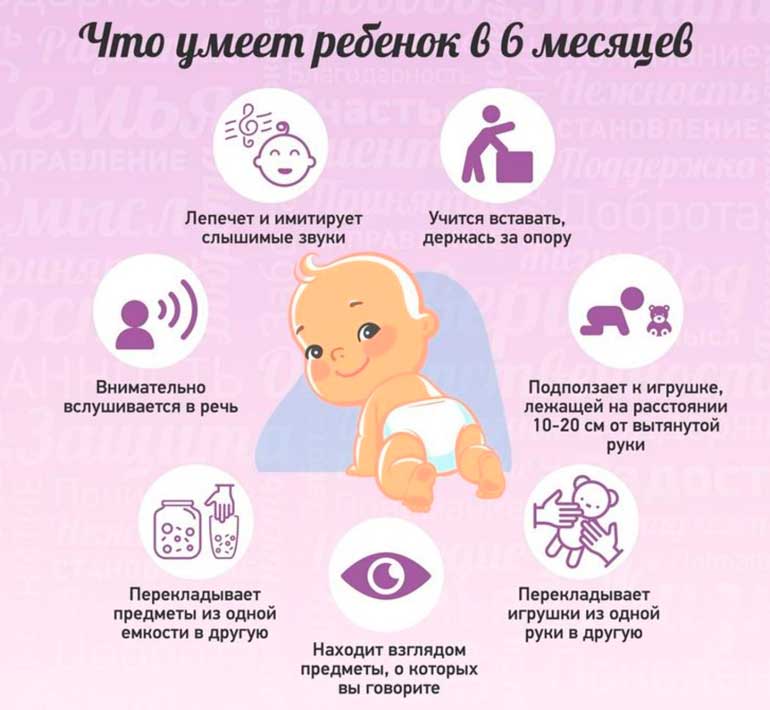
Test for the development of the baby in six months
- Hold the toy at a distance of 20-30 cm from the child. He must be able to look from the surroundings to the toy, distinguishing it from everything else;
- Offer the child a bottle of milk first, and then a toy. The reaction of the baby should be different: when he sees the food, the baby opens his mouth and can make sucking movements, at the sight of a toy there will be a reaction of revival;
- When the baby is lying, ring a bell in front of him, and then slowly push him back. The child with your help will begin to rise and move into a sitting position;
- Talk with your child, changing facial expressions. The baby will begin to repeat after you: wrinkles his forehead, smiles;
- Try to take away the toy that he holds in his hand from the baby. At 6 months, the baby will hold the subject firmly and resist, expressing dissatisfaction;
- If you often call the baby by name, then at this age the baby should already react to it with a complex of animation.
What should alert

- The child cannot and does not try to sit, even with support;
- When you support the baby for the armpits, he does not “dance”;
- Does not transfer an item from one handle to another;
- Does not respond to sounds that are out of sight;
- Do not ask for pens;
- Does not babble, does not smile, does not recognize parents.
Detailed information: what should a child be able to do at 6 months
Mom Lara: The development of a child in half a year
The introduction of complementary foods
The most favorable age for starting the introduction of complementary foods is six months. Until this time, breast milk provides the baby's body with all the necessary substances. When feeding the mixture, the first feeding is introduced a little earlier - from 4 to 5 months. When it comes to the timing of the introduction of complementary foods, it means the end of the month in which it begins.
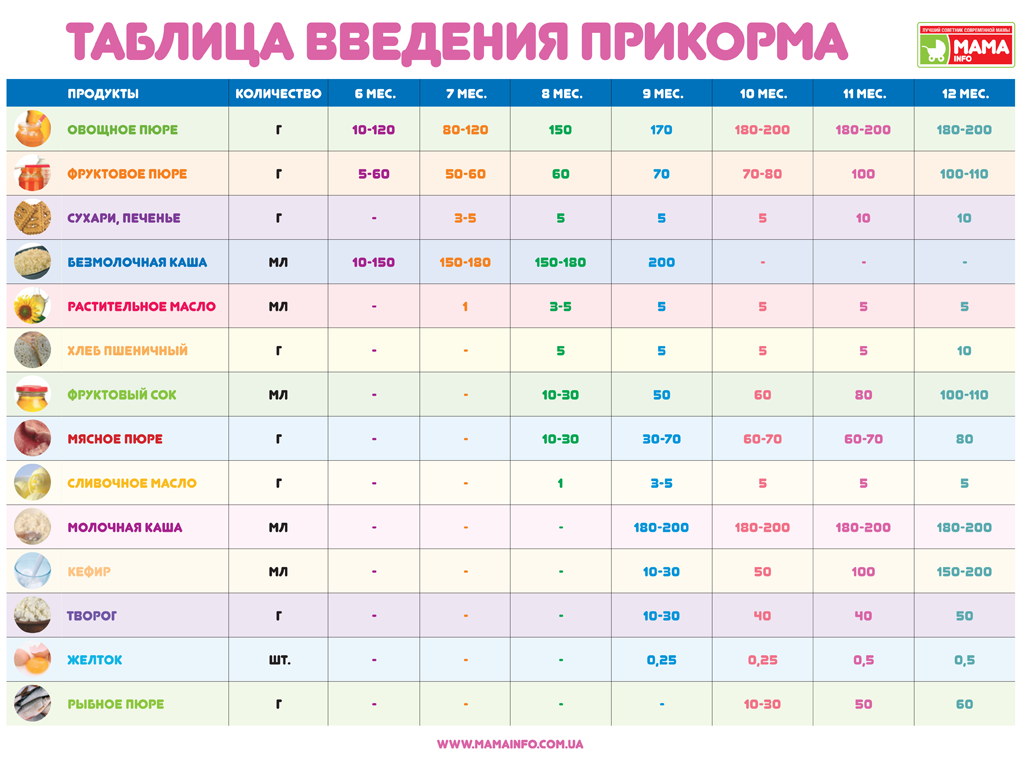
After 6 months, neither breast milk nor the mixture can no longer compensate for the energy costs that go into intensive growth, physical development. The baby's body begins to need a lot of minerals, trace elements and plant proteins.
If you start complementary foods after the deadline (6 - 7 months), then it will be difficult for the child to adapt to the new food and its consistency.Late introduction of complementary foods is fraught with the occurrence of deficient conditions (hypotrophy, anemia, rickets), poor development of chewing skills and taste perception, as well as the need for the simultaneous introduction of several products, which can cause an allergic reaction or digestive disturbance.
It is important that the baby is ready for feeding. Be sure to consult a pediatrician before giving new food. If the baby is choking or spitting out food, then wait a bit with the innovation.
So, it is more convenient to start complementary foods in the morning, before feeding. Children prone to constipation or overweight, it is better to start with vegetable puree from zucchini, cauliflower, broccoli. Thin people can start with gluten-free cereals: buckwheat, rice or corn, cooked in water without salt and sugar. The first mashed potatoes and cereals should be monocomponent, that is, contain only one vegetable or cereal.
In summer and autumn, there is usually the opportunity to find quality vegetables. Before use, they must be processed and boiled, preferably steamed (this leaves more nutrients). Mashed potatoes should be homogeneous, that is, not contain lumps and not very thick. To do this, use a blender and, if necessary, add water or a decoction on which vegetables were cooked. Or use ready-made baby purees in jars. Teach your baby to eat right away with a spoon. Use teat bottles only when necessary (on the go). Do not give hot food or from the refrigerator, optimal temperature 370C.
They begin to enter with 1 \ 2 - 1 teaspoon, and then they are fed with milk or a mixture. For 5 - 10 days, bring to 150 - 180 g and completely replace one breast-feeding. The rest of the time, continue to feed on demand. New products are introduced only after being used to the previous one. You cannot enter more than one new product. Multi-component mashed potatoes and cereals can be given only from about 7 months.
Lure. Useful Tips for Moms
Watch for stool and allergic reactions in the child. If you are allergic to something, then cancel this product and try again later.
We read: About the first feeding
Weaning from the nipples
Weaning from the nipples: if the first tooth has already appeared in the crumbs, be sure to try to wean it from the dummy. The pressure exerted by the nipple on the gums can lead to curvature of the teeth. Better buy your baby a teether ring. It is easier to wean from the nipple during the introduction of complementary foods, as the baby begins to learn to drink from the cup, and nightly feeding from the bottle is becoming rare or completely disappears.
We read in detail: How to wean a baby from a nipple
Baby's sleep at 6 months (regimen)
After 6 months, the baby sleeps about 14 hours a day: two sleeps of 1.5 - 2 hours - day and night - up to 6 - 7 hours in a row. But still, the mode remains individual. Many babies continue to ask for breasts several times a night - this is normal and can last until you stop breastfeeding. Be patient. So that the child sleeps longer at night:
- The interval between the last daytime sleep and nightly bedding should be at least 4 hours.
- Bathe your baby before bedtime. Warm water relaxes and soothes.
- After bathing feed your baby.
We also read: 6 months baby's day regimen
How to help your baby grow: games
Continue to stimulate the development of speech in the baby, as in previous months. Buy your child some small colorful books with cardboard pages that he can turn over. It is better if the books are not just with pictures, but with short poems or nursery rhymes in which words and phrases are repeated. Children who have been reading rhymes from 6 months old begin to speak earlier.
The centers that are responsible for fine motor skills and speech in the brain are very close and interconnected, therefore it is important to conduct classes with the child aimed at the activity of the fingers:
- Kids at this age adore games with boxes or cookie cutters of different sizes, matryoshkas.
- Make a few bags with different fillings: dried peas, beans, coarse salt, millet, pebbles, buttons.
- Take a ball 5 - 6 cm in diameter, put it in the baby's hands. With your own hands, squeeze the outside of his handles with the ball inside and roll it there. You can roll a walnut. Do 3 to 4 minutes daily.
- Massage your fingers: gently massage them in turn and gently sip. Do 2 to 3 minutes every day.
- “Combing”: take turns raising the child’s arms and gently moving them along the head back and forth.
- Squeezing and unclenching a tweeter toy.
- Spiral toys on which to move the figures.
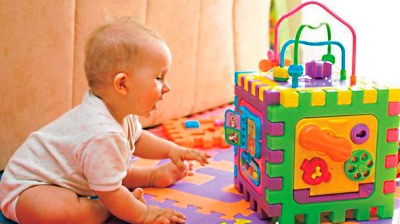
Remaining relevant are the games in The Forty-Crow, Ladushka, Ku-ku, Goat Horned.
If the baby is able to do something new, be sure to praise him. The child already feels that you are happy with him.
Increasing the number of toys exponentially is a problem that all parents face. In order not to litter the house with ten successive tumblers and cubes that bother the baby already on the 3rd day, divide all the toys into two parts. Give one part to the kid for games, and hide the rest. Every 4 to 5 days, change toys. Keep in mind that at 6 months the baby can play with up to two toys at a time.
Read reviews: inexpensive online stores of children's goods and toys
The kid will soon begin to crawl, so in a crib or playpen he becomes cramped. Give the baby a carpet on the floor and lay some toys on it, let the baby try to crawl to them.
Continue to do gymnastics and hardening massages daily.
Try to keep all activities and games with the child simple and useful. Do not overload the baby, his psyche is not ready yet for long classes. Now the child needs your love and attention even more. If you want to make his life joyful, follow each of your words and actions, which are now imprinted in the subconscious of a small person.
Supermoms: How to assess a baby’s development at 6 months
Mom’s school: Sixth month of life. Child Development Calendar
![]() A full calendar of the development of the child in one article “development up to a year by months” -https://kid.htgetrid.com/en/razvitie-rebenka-do-goda/razvitie-rebenka-do-goda-po-mesyatsam.html >>>
A full calendar of the development of the child in one article “development up to a year by months” -https://kid.htgetrid.com/en/razvitie-rebenka-do-goda/razvitie-rebenka-do-goda-po-mesyatsam.html >>>



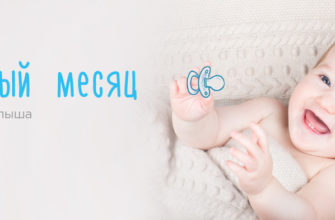
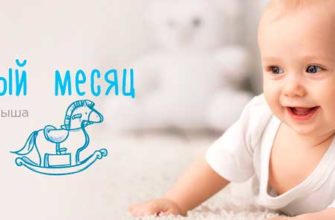


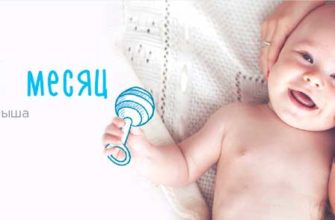

thanks for the nice article!
We introduced complementary foods when I began to sit confidently myself, with the second we plan the same way, yesterday we turned 6 months. While not sitting. Weight gain is normal.
The article is very helpful and well written. I found a lot for myself. thank you agrome! we are fed 5.5 lure mashed porridge and kefir. two teeth crawled out, not yet sitting, but flips from the abdomen to the back. It does not give away toys. does not like a pacifier. Well, now I won’t give it at all, only a tooth ring